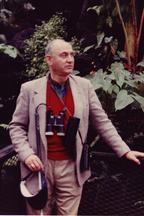
DOWNTOWN — A quick Google search of Dr. Samuel Genensky pulls an impressive resume of accomplishments during his 81-year-life, from the time spent as a mathematician at the RAND Corp. where he invented a reading device for the visually impaired, to the Disabilities Commission on which he served as an original member.
It’s the legacy that friends of the late Santa Monica resident and founder of the Center for the Partially Sighted, who died June 26 from heart complications, say they will remember, one of a tireless advocate who spent the greater part of his life fighting for people with severely low vision.
“It’s sad to lose him but at the same time, I’m really very thankful that we had this time with him where we could hear from him and get his contribution and input on so many important issues that faced the disabilities community in Santa Monica,” Chris Knauf, the chairman of the Disabilities Commission, said.
Genensky was born July 26, 1927 in New Bedford, Mass. with full vision, but was left nearly blind a few hours postnatal after a doctor mistakenly dropped silver nitrate in his eyes. A surgery about four months later improved his sight to 20/1000 in his right eye, while his left remained visionless.
But he refused to let the condition be a disability, finishing his first eight years of school in seven years and using binoculars to better see the blackboard, later creating a low-vision bifocal by replacing a distance lens with a reading lens, which came in handy during his time studying at Brown and Harvard universities.
Genensky went on to father similar assistive devices, one of the most famous being the first user-friendly closed-circuit TV system for the partially sighted to use for reading and writing. He also designed and lobbied for sign modifications that would allow for one to distinguish between the men’s and women’s restrooms — triangle for the former and oval for the latter.
Most recently Genensky successfully convinced city officials to install talking crosswalks at 23rd Street and Wilshire Boulevard near where he lived.
“He was tireless, he was determined,” Christofer Arroyo, who served on the Disabilities Commission with Genensky, said. “He’s done all these things himself.”
But perhaps the project most dear to his heart was the Center for the Partially Sighted, which he founded in the former Santa Monica Hospital 31 years ago.
Today located one block east of the Santa Monica city limits on Wilshire Boulevard, the nonprofit organization provides vision care, rehabilitation and support group services to more than 2,300 individuals from the L.A. area every year, helping those with low vision best utilize their remaining eyesight, whether it’s prescribing corrective lenses or making in-home visits to make the residences more livable.
Genensky founded the center after an article ran in Reader’s Digest about the CCTV system, which led to calls and visits to his office from those who had long struggled with their vision problems. It was then he realized that there were no available services that tailored to the special needs of the partially sighted.
“He really felt that it was a major part of the visually impaired population that had been ignored,” LaDonna Ringering, the president and CEO of the center, said. “In that sense he was a visionary.”
Up until a few months ago, Genensky came by the center about twice a week to make calls to long-time donors. Those calls continued even after his illness made it difficult to make the trip, instead picking up the phone from his home office. The calls stopped about a few weeks before his death.
“He was such a huge role model to people and their families to give them hope they could accomplish whatever they wanted to as long as they put their minds to it and energy to it and were willing to work hard,” she said.
Genensky was also involved with City Hall, serving on a task force that was responsible for determining whether the City Council should create a Disabilities Commission. He then served on the Disability Community Accessibility Committee which studied various issues in the city, eventually recommending that a permanent committee be formed. The City Council appointed Genensky to the Disabilities Commission in 2002.
Knauf said Genensky served a curmudgeonly role, one who was always the counterpoint and urged the commission to get on with their business.
“He was just a force to get us to do the right thing,” Knauf said. “Not everyone always agreed with him, but he was a pleasure to have.”
The commission met on Monday night when they were scheduled to discuss a tribute for their late colleague.
Outside of advocacy work, there was life with Nancy Cronig, his second wife.
They met through Cronig’s late husband, who became friends with Genensky after moving to New Bedford as a teenager, seeing himself as “Sam’s protector,” Cronig said.
“(Genensky) would take out his binoculars at the restaurant to scan the menu on the wall for food and people would start making fun or just couldn’t understand what this man was doing with the binoculars,” Cronig said. “My first husband stood right up to them.”
They married 14 years ago, long after their spouses died. The couple each had children from previous marriages.
Cronig remembers Genensky’s nearly daily walks to Douglas Park where he brought his talking book device and sat on a bench, smelling the air and listening. Despite his vision, Genensky was also an avid bird watcher.
With all his accomplishments over the years, Cronig believes opening the center was her husband’s high point.
“I’m receiving letters from all over the world expressing gratitude for Sam and for all he’s done for the partially-sighted people,” she said.
melodyh@www.smdp.com








